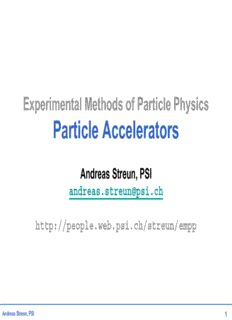
Particle Accelerators PDF
Preview Particle Accelerators
Experimental Methods of Particle Physics Particle Accelerators Andreas Streun, PSI [email protected] http://people.web.psi.ch/streun/empp Andreas Streun, PSI 1 Particle Accelerators 1. Introduction 2. Accelerator basics and types 3. Transverse beam dynamics 4. Longitudinal beam dynamics 5. Emittance 6. Synchrotron radiation 7. Luminosity 8. Muons and neutrinos Andreas Streun, PSI 2 1. Introduction (cid:1) Books & webs (cid:1) Why accelerators? (cid:1) Particles (cid:2) Particles of interest (cid:2) Particle wavelength and momentum (cid:2) Particles to accelerate (cid:2) Particle production (cid:1) A beam of particles (cid:2) Beam quality (cid:2) Accelerator peformance (cid:1) Particle Physics experiments (cid:2) Center-of-mass energy (cid:2) Luminosity Andreas Streun, PSI 3 Books & Webs (cid:1) K. Wille, Physik der Teilchenbeschleuniger und Synchrotronstrahlungsquellen, Teubner Studienb(cid:252)cher, Stuttgart 1992. (cid:1) K. Wille, The physics of particle accelerators, Oxford university press, 2005. (cid:1) S. Y. Lee, Accelerator Physics, World Scientific, Singapore 1999 (cid:1) H. Wiedemann, Particle Accelerator Physics I+II, Springer, Berlin Heidelberg New York 2007. (cid:1) Proceedings of The CERN Accelerator School http://cas.werb.cern.ch/cas/ (cid:1) A. W. Chao and M.Tigner, Handbook of Accelerator Physics and Engineering, World Scientific, Singapore 1998. (cid:1) Proceedings of the Accelerator Conferences http://www.jacow.org/ Andreas Streun, PSI 4 I. Why accelerators? →→→→ Applications length scale 10-10 m = 1 ¯ / atomic 10-15 m / nuclear 10-18 m / electroweak Nuclear Materials Particle Physics (NP) Research (MR) Physics (PP) Physics Energy frontier Chemistry Particle Particle factories Accelerators Biology Exotic particles Pharmacy Medical applications Industrial applications Andreas Streun, PSI 5 II. Why accelerators? →→→→ Connections Hamiltonian Mechanics Classical Physics Electrodynamics Engineering Particle Radio-frequency Modern Physics Accelerators Magnet technology Quantum mechanics Ultra high vacuum Computing Particle Physics Mechanical engineering High performance computing Alignment & Survey Accelerator design codes Electronics Digital signal processing s/w Control systems Application programming Andreas Streun, PSI 6 III. Why accelerators? →→→→ common PP & MR interests Particle Physics (PP) Materials Research (MR) High energy Particle Neutrino Spallation Photon colliders factories factories neutron sources sources Linear Circular High power proton Storage Free electron colliders colliders accelerators rings lasers (FEL) A c c e l e r a t o r s Linear accelerators Cyclotrons Synchrotrons (cid:3)(cid:3)(cid:3)(cid:3) PP & MR scientists: understand potential and limitations of accelerators (cid:3)(cid:3)(cid:3)(cid:3) help to specify future machines Andreas Streun, PSI 7 Particles of interest (PP) Particle Physics: interested in all particles! presently: particular interest in (cid:1) new and unknown particles: o W– (80.4 GeV), Z (91.2 GeV), H (>115 GeV), ...? produced in e++++e−−−−or pp or pp collision (cid:3) highest energies: e.g. LEP, LHC o o (cid:1) meson pairs (e.g. K K , B B ) at high rate S L (cid:3) meson factories: e.g. KEK-B, DAΦΦΦΦNE. (cid:1) muons (µµµµ– ) and neutrinos (νννν ,νννν ) e µµµµ (cid:3) long baseline experiments: e.g. CNGS, JPARC (cid:3) muon accelerator and neutrino factory projects Andreas Streun, PSI 8 Particles of interest (MR) Materials Research: neutral particles (cid:3) high penetration depth in materials (cid:1) Neutrons (n) (cid:2) penetrate high Z materials (cid:2) depth not a steep function of Z (cid:2) have a magnetic moment and a spin (cid:2) explore structure and dynamics of materials (cid:2) rather low flux (= particles per time and area) (cid:1) Photons (γγγγ) (cid:2) available at (very!) high flux (cid:2) penetrate well low Z materials (cid:2) have polarization (cid:2) complementary to neutrons ((cid:147)surface vs. bulk(cid:148)) Andreas Streun, PSI 9 Particle wavelength (cid:4) Size of structure Size of probe (cid:3)(cid:3)(cid:3)(cid:3) (cid:3)(cid:3)(cid:3)(cid:3) MR λλλλ ~ 10-10 m NP (cid:3)(cid:3)(cid:3)(cid:3) λλλλ ~ 10-15 m PP λλλλ ~ 10-18 m h De-Broglie wavelength λ= p Planck constant non (cid:150) relativistic h = 6.63•10-34 Js = 4.14•10-15 eV•s p = m v o Particle momentum c < < v p = m v = m c βγ • • high relativistic o v ≈≈≈≈ c p= m c γ= Ε / c • o Andreas Streun, PSI 10
Description: